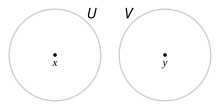Hausdorff room
A Hausdorff space (also Hausdorff's space ; after Felix Hausdorff ) or separated space is a topological space in which the axiom of separation (also called Hausdorff property or Hausdorff's axiom of separation ) applies.
definition
A topological space has the Hausdorff property if there are disjoint open environments for all with and .
In other words: All pairs of different points and out are separated by surroundings . A topological space that fulfills the Hausdorff property is called a Hausdorff space.
properties
A Hausdorff space can be characterized by any of the following properties that are equivalent to the Hausdorff property:
- Each filter on converges to at most one point .
- Each one-point set is the average of its closed surroundings.
- The diagonal is closed with regard to the product topology .
In particular, in Hausdorff spaces, limit values of sequences - unlike in general topological spaces - are unambiguous. A sequence converges to a point in a topological space if there exists for every neighborhood of a , so that applies to all .
Sub-rooms of Hausdorff rooms in turn form Hausdorff rooms. The Hausdorff property is also transferred to any products from Hausdorff rooms.
Classification in the hierarchy of topological spaces
Comparison with weaker separation properties
According to the definition, every Hausdorff space has the T 1 separation property and is therefore also a T 0 space .
A topological space is a Hausdorff space if and only if it is pre-regular ( R 1 ):
- all pairwise topologically distinguishable points and from are separated by neighborhoods,
and has the Kolmogoroff property ( T 0 ):
- all points different in pairs and off are topologically distinguishable .
Two points are topologically distinguishable and if and only if there is an open set that contains one point but not the other. The points are "Separated by environments" by definition when it open environments with there.
Proof:
- If R 1 and T 0 are given, T 2 follows immediately : this conclusion can be drawn purely formally without knowing what topologically distinguishable actually means.
- The reverse conclusion from T 2 to R 1 and T 0 goes like this:
- From the definition of T 2 it follows for different ones the existence of the set which , but does not contain, therefore T 0 holds .
- Be , two topologically distinguishable points: there is a lot that contains the one point, the other not; thus is . Then with T 2 it follows that and are separated by neighborhoods. Hence, R 1 applies .
Tightening of the Hausdorff property
- In the above definition, if one can even choose the open sets in such a way that their closings are also disjoint, one speaks of a Urysohn space .
- If there is a continuous function of the space in the real numbers for two different points , which takes on different values at these points, then the space is called a complete Hausdorff space .
- Further tightening of this term can be found in the article " Axiom of Separation ".
Examples
Almost all of the spaces considered in analysis are Hausdorff spaces. In particular, every metric space is a Hausdorff space.
In contrast to filter convergence, the uniqueness of sequence limit values is only a necessary condition for the Hausdorff property. If z. If, for example, an uncountable set such as the real numbers with the co-countable topology is used , one obtains a non-Hausdorffian space in which convergent sequences have exactly one limit value.
An example of a Hausdorff space that is not a metric space is the set of countable ordinal numbers with the usual order topology .
If the spectrum of a ring is provided with the Zariski topology , a sober topological space is obtained , which is usually not pre-regular, let alone Hausdorff-like.
Many examples of non-Hausdorff spaces are obtained as quotient spaces of manifolds with respect to some group effects or more general equivalence relations . For example, the leaf space of the Reeb foliation ( i.e. the quotient space with regard to the equivalence relation: two points are equivalent if and only if they belong to the same leaf) is not Hausdorff's.
Localuclidean spaces do not have to be Hausdorffian. The space resulting from two copies of the identification of an open interval is locally homeomorphic to , but not Hausdorffian.
annotation
- The concept of the separated room (= Hausdorff room ) has no relation to the concept of the separable room .
literature
- Lutz Führer : General topology with applications . Vieweg Verlag, Braunschweig 1977, ISBN 3-528-03059-3 .
- Jürgen Heine: Topology and Functional Analysis . Basics of abstract analysis with applications. 2nd, improved edition. Oldenbourg Verlag , Munich 2011, ISBN 978-3-486-70530-0 .
- Horst Schubert: Topology (= mathematical guidelines ). 4th edition. BG Teubner, Stuttgart 1975, ISBN 3-519-12200-6 ( MR0423277 ).
- Dirk Werner : Functional Analysis. (= Springer textbook ). 6th, corrected edition. Springer, Berlin et al. 2007, ISBN 978-3-540-72533-6 .
- Stephen Willard: General Topology (= Addison-Wesley Series in Mathematics ). Addison-Wesley , Reading, Massachusetts et al. a. 1970, p. 224 ff . ( MR0264581 ).
- Boto von Querenburg : Set theoretical topology. (= Springer textbook ). 3rd, revised and expanded edition. Springer, Berlin et al. 2001, ISBN 3-540-67790-9 .
Individual evidence
- ↑ Horst Schubert: Topology. 1975, p. 58.






















